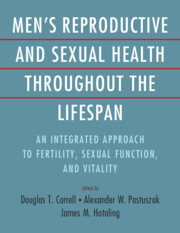 Men's Reproductive and Sexual Health Throughout the Lifespan
Men's Reproductive and Sexual Health Throughout the Lifespan Book contents
- Men’s Reproductive and Sexual Health throughout the Lifespan
- Men’s Reproductive and Sexual Health throughout the Lifespan
- Copyright page
- Contents
- Contributors
- Preface
- Section 1 An Introduction to Men’s Health Care
- Section 2 The Biology of Male Reproduction and Infertility
- Section 3 Clinical Evaluation and Treatment of Male Infertility
- Section 4 Laboratory Evaluation and Treatment of Male Infertility
- Section 5 Medical and Surgical Management of Issues of Male Health
- Chapter 32 Hypogonadism in the Male
- Chapter 33 Selective Androgen Receptor Modulators in the Treatment of Hypogonadism and Men’s Health
- Chapter 34 Male Fertility and Testosterone Therapy
- Chapter 35 Sleep and Men’s Health
- Chapter 36 Molecular Biology and Physiology of Erectile Function and Dysfunction
- Chapter 37 Evaluation of the Male with Erectile Dysfunction
- Chapter 38 Lifestyle Modifications for Erectile Dysfunction
- Chapter 39 Medical and Surgical Management of Erectile Dysfunction
- Chapter 40 Surgical Management of Peyronie’s Disease
- Chapter 41 Medical Management of Benign Prostatic Hyperplasia
- Chapter 42 Evidence-Based Management of Chronic Orchialgia and Chronic Prostatitis/Chronic Pelvic Pain Syndrome
- Index
- References
Chapter 36 - Molecular Biology and Physiology of Erectile Function and Dysfunction
from Section 5 - Medical and Surgical Management of Issues of Male Health
Published online by Cambridge University Press: 06 December 2023
- Men’s Reproductive and Sexual Health throughout the Lifespan
- Men’s Reproductive and Sexual Health throughout the Lifespan
- Copyright page
- Contents
- Contributors
- Preface
- Section 1 An Introduction to Men’s Health Care
- Section 2 The Biology of Male Reproduction and Infertility
- Section 3 Clinical Evaluation and Treatment of Male Infertility
- Section 4 Laboratory Evaluation and Treatment of Male Infertility
- Section 5 Medical and Surgical Management of Issues of Male Health
- Chapter 32 Hypogonadism in the Male
- Chapter 33 Selective Androgen Receptor Modulators in the Treatment of Hypogonadism and Men’s Health
- Chapter 34 Male Fertility and Testosterone Therapy
- Chapter 35 Sleep and Men’s Health
- Chapter 36 Molecular Biology and Physiology of Erectile Function and Dysfunction
- Chapter 37 Evaluation of the Male with Erectile Dysfunction
- Chapter 38 Lifestyle Modifications for Erectile Dysfunction
- Chapter 39 Medical and Surgical Management of Erectile Dysfunction
- Chapter 40 Surgical Management of Peyronie’s Disease
- Chapter 41 Medical Management of Benign Prostatic Hyperplasia
- Chapter 42 Evidence-Based Management of Chronic Orchialgia and Chronic Prostatitis/Chronic Pelvic Pain Syndrome
- Index
- References
Summary
Male erectile dysfunction is a common condition that can significantly impact quality of life and interpersonal relationships. It is strongly associated with aging, comorbid conditions, poor lifestyle, and adverse cardiovascular health. Deficits in psychologic, neurologic, vascular, and endocrine function can all lead to erectile dysfunction. The aim of this chapter is to review the molecular biology required for erectile function as well as delve into the clinical pathophysiology that leads to erectile dysfunction.
Keywords
- Type
- Chapter
- Information
- Men's Reproductive and Sexual Health Throughout the LifespanAn Integrated Approach to Fertility, Sexual Function, and Vitality, pp. 289 - 294Publisher: Cambridge University PressPrint publication year: 2023
